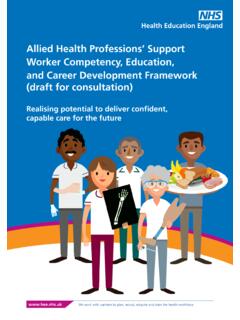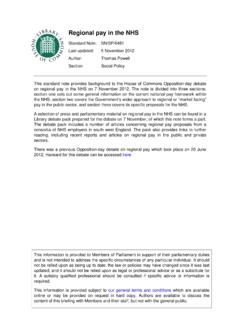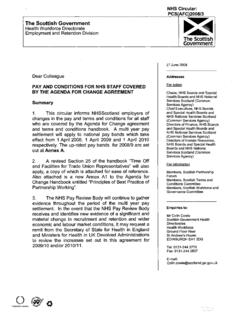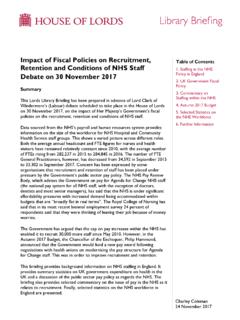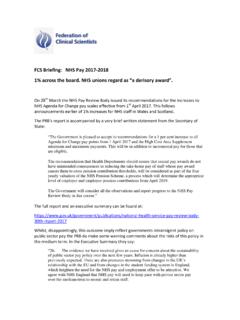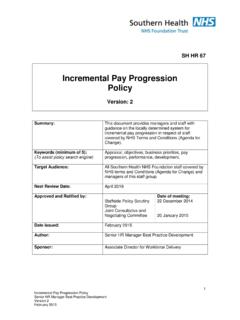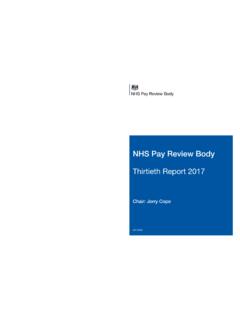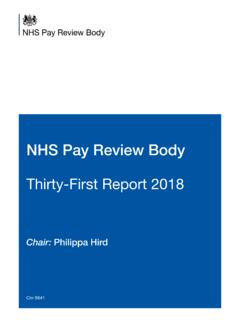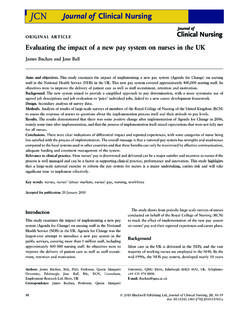Transcription of Health Education England’s written evidence for 2018/19
1 NHS Pay review body Health Education England s written evidence for 2018/19 1 Introduction Health Education England (HEE) welcomes the opportunity to once again submit evidence to the Doctors and Dentists review body (DDRB) as part of its national process of gathering evidence from interested parties to inform the recommendations for 2018/19 . HEE exists for one reason only: to help improve the quality of care by ensuring our workforce has the right numbers, skills, values and behaviours to meet the needs of patients. When we were established in 2013, we took over the functions of the former strategic Health authorities (SHAs) and their Deaneries for workforce planning, Education commissioning and Education provision. It was the first time that responsibility for all of these functions were within the same body , and by doing so, our aim was to improve both national consistency and standards and local leadership and decisions.
2 We recruit doctors and dentists into training and we support the training of a range of multi-professional staff and apprentices. We are also responsible for supporting the NHS Constitution and helping to embed the NHS Values into everyday activity in the NHS. We are now in our fifth year as HEE, providing the NHS with a single national body with a ring-fenced budget for commissioning Education and training places to secure the future workforce. Our four local Education and training boards (LETBs), regionally based and employer-led, provide a single strategic forum for their region in which Health care economies can come together to discuss and agree plans and actions on the local workforce. We operate a single system of dispersed leadership, working together to deliver both local and nationwide success. To achieve this, we are proud to also work with: The providers of NHS services who are ultimately responsible for employing, maintaining and developing their staff and the quality of care they provide; and Sustainable Transformation partnerships (STPs) and Local workforce Advisory Boards (LWABs); and Other organisations such as commissioners, local authorities and higher Education providers.
3 We also have a wider role working nationally with the Department of Health (DH) and other Health Arms Length Bodies (ALBs) and Non-Departmental Public Bodies, including NHS England, NHS Improvement, the Care Quality Commission and Public Health England. Together, HEE and these organisations developed the NHS Five Year Forward View which was published in October 2014. The purpose of the Five Year Forward View is to articulate why change is needed, what that change might look like and how we can achieve it. The Five Year Forward View was refreshed in March 2017 with the publication of the Next Steps On The Five Year Forward View which acknowledged the progress that had been made but highlighted the emerging pressures within the service and refocused the Five Year Forward View priorities in the light of this. In October 2016, HEE was asked to lead the development of the first NHS Workforce Strategy for over 25 years, in recognition of the need for further co-ordination at national level to ensure that the issues facing the NHS with regard to the supply and development of staff were discussed, and actions agreed, with a broad range of national, regional and local stakeholders.
4 (See section 3). The development of the draft strategy has been a priority for HEE, and much of the evidence and commentary that would routinely be supplied to the pay review bodies is contained within the draft document. As a result, our formal evidence for 2017/18 is of a different nature and we welcome the opportunity to discuss the draft with review body members, and to use that discussion as part of our formal consultation on the Strategy itself. 2 Background During 2017, HEE undertook a significant reorganisation as a result of the funding changes announced by the Government in the Comprehensive Spending review in November 2015. Within these changes, it is important to re-emphasise that significant areas of our responsibilities remain the same. We have retained our statutory responsibility for continuing to improve the quality of Education and training of Health care staff, and to ensure the sufficient supply of the future workforce.
5 In tandem with this, our focus on the future, alongside our need to ensure that excellent Education and training is being delivered today, remains as important as ever. However, our operating model was revised as a result of this, with more focus on the NHS workforce of today, with our regional and national teams taking forward aspects of our core portfolio. In 2016, we reduced the number of our local Education and training boards (LETBs) from 13 to 4, and at the same time we renewed our focus on the 4 regions as a result of this. We have also supported the introduction of Sustainability and Transformation Plan areas (STPs), bringing Health and care providers (and appropriate ALB leads) closer together at local level. We have seen a consequent change in role for HEE s 13 local offices and the staff that lead local services. There is now a new focus on HEE as the centre of expertise on workforce intelligence and data and the potential to act as a catalyst for, and a co-ordinator of, the cross-system changes required insofar as they relate to the NHS workforce.
6 In the light of changes to our commissioning role, the reductions in our running cost budgets and the place-based planning emerging from the NHS Five Year Forward View, we have worked with staff and stakeholders to develop five revised over-arching corporate objectives for HEE: Thinking and leading - we will lead thinking on new workforce policy solutions in partnership with the Department of Health and others as appropriate to support high quality and sustainable services; Analysing and influencing - we will use high quality data, evidence , advice and workforce expertise to influence the delivery of NHS priorities; Changing and improving - we will design and respond positively to innovative recruitment, retention, development and transformation initiatives locally, regionally and nationally which change and improve NHS services and quality of care; Delivering and implementing - we will deliver high quality Education and training, implement our Mandate and support partner-led programmes to improve the quality of care and services; Focusing on tomorrow - we will strategically focus on the future including new roles and pathways to the professions and helping the NHS workforce embrace new technology.
7 The structures and operating models that we have now implemented are all predicated on the following; That we have taken a fresh look at how our functions and services might be delivered, and how they can be improved as part of this process. That we are responding to system changes, such as the requirement to better support STPs and the impact of HEE s reduced role in non-medical Education commissioning. That we will continue to work on the basis of doing what can best be done once (nationwide) or four times (regionally) or more (at local or STP level). That we continue to learn from changes elsewhere within HEE or the wider NHS, or beyond. That we continue to maintain quality while we look to develop capacity and capability, albeit in a different way. That we must deliver our Mandate. That we ensure that the changes we make are safe for our staff, for our trainees and learners, and for patients of the NHS.
8 HEE s key areas of responsibility have changed as a result of the Comprehensive Spending review and government policy around Education , but we have retained our core business around the delivery of postgraduate medical and dental Education , from recruitment, Education provision and assessment including the Annual review of Competence Progression (ARCP) process through to learner support, including focused performance support and faculty support and development. We have taken the opportunity to highlight that our transformation offer in STPs, through the Local Workforce Action Boards (LWABs) must be a priority. We have developed LWABs to support local communities (through their STPs) to help to bridge the quality, finance and safety gap across the NHS. The LWABs are chaired by senior executives on behalf of the STP and co-chaired with members of HEE s Senior Management Team. Our role in supporting workforce transformation is key to ensuring that local action is being taken to ensure: The availability of workforce intelligence A supply pipeline for the identified future workforce That workforce development and transformation enablers are in place That quality is built into every aspect of Education and training That a focus on leadership and organisational development is embedded across the STP.
9 The transformational role that we are leading on through the LWABs is critical to both the success of HEE and the Five Year Forward View. The principles for our redesign were: The creation of regional services providing dedicated knowledge and skills hubs Consistent quality in the provision of services to trainees, NHS providers and other key stakeholders Alignment of resources and expertise to support STPs Future proofing of services following the Comprehensive Spending review Commonality and consistency in approach to ways of working Driving efficiency through doing things once nationally, once regionally or locally where service delivery requires. These are all needed in order to ensure: A greater connection between national policy and regional delivery Strengthening Mandate delivery through national and regional transparency Maintaining and developing local responsiveness Supporting the delivery of 5 YFV and thematic sub groups Supporting the STPs through the LWAB infrastructure Better affordability and reduced duplication across the regions Improved collaboration with NHS England (NHSE) and NHS Improvement (NHSI).
10 In order to achieve better alignment with our key partners in NHSE and NHSI, our model for this part of the business needed to operate on the same footprint as the other ALBs, as far as is practicable. HEE s Local Directors are the key account managers for the STP footprint and the consequent transformation agenda and will support the delivery of Workforce Transformation through the LWABs. In order to this, going forward we will; Focus and shape the resource requirements for Workforce Transformation through an internal consultancy approach Set out the regional delivery of workforce planning Set out the regional delivery of non-medical commissioning and arrangements for medical commissioning Set out the relationships and communications with other customer facing regional services Agree the service and account management arrangements to support this. 3 Facing the Facts, Shaping the Future The NHS needs radical action to improve working conditions, boost training and retention and become a model employer for staff.


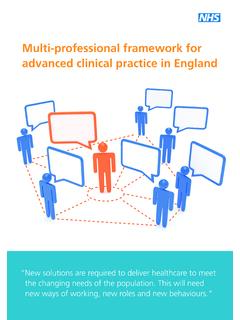

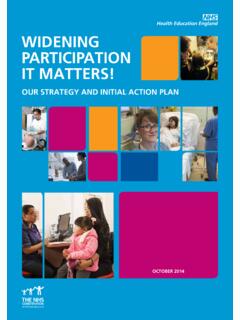


![Midlands [1 of 2] - hee.nhs.uk](/cache/preview/6/c/1/4/2/e/2/7/thumb-6c142e2790d053a442bd8a3e81c79697.jpg)

